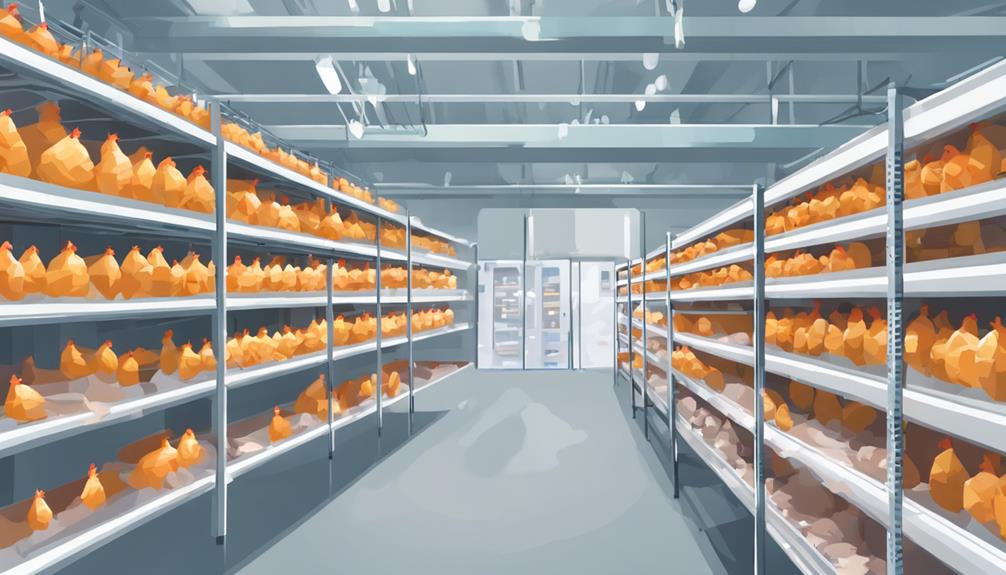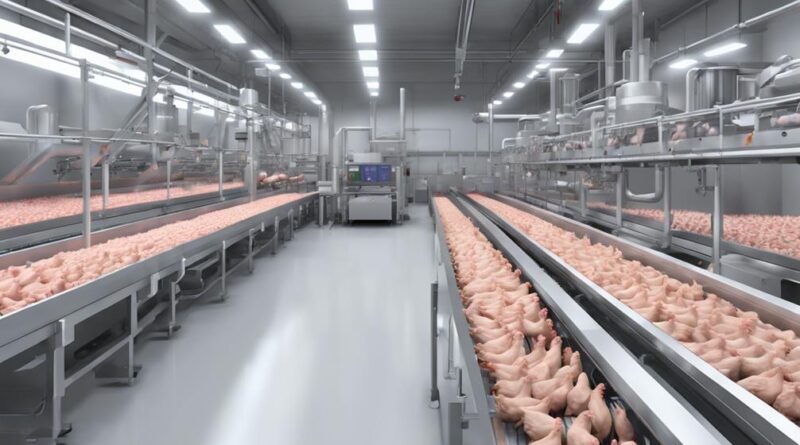Boosting Efficiency in Chicken Product Processing: Top Tips"
To optimize your chicken product processing efficiency, mastering key techniques like quick bleeding and precise artery severing is paramount. Incorporating advanced evisceration methods and ensuring your deboning equipment is finely tuned can significantly enhance your operations. But that's just the beginning. From fine-tuning packaging strategies to embracing automation and stringent quality control, a multitude of steps can elevate your processing game. Stay tuned to discover how each facet plays a crucial role in boosting your chicken processing efficiency to new heights.
Efficient Slaughtering Techniques
To boost efficiency in chicken product processing, implementing streamlined slaughtering techniques can significantly improve productivity and resource utilization. Quick bleeding and proper stunning are two crucial components of efficient slaughtering processes.
Quick bleeding is essential to ensure minimal suffering for the chickens and maintain product quality. By swiftly and accurately severing the carotid artery and jugular vein, blood is drained rapidly, leading to faster and more humane deaths. This step requires precision and skill to minimize stress on the birds and prevent unnecessary pain.
Proper stunning is another key aspect of efficient slaughtering techniques. Stunning chickens correctly before slaughter is vital to ensure they're unconscious and insensible to pain. This process can be done using electrical stunning methods, which induce immediate unconsciousness, or mechanical stunning, which causes immediate brain death. Implementing the right stunning method is critical to maintain product quality and meet ethical standards.
Streamlining Evisceration Process
Efficiently streamlining the evisceration process is key to maintaining the productivity and resource utilization improvements achieved through optimized slaughtering techniques in chicken product processing. Evisceration automation plays a crucial role in enhancing efficiency. Automated systems can handle the removal of internal organs swiftly and accurately, reducing the need for manual labor and ensuring consistent results. By implementing evisceration automation, you can significantly increase throughput while maintaining product quality.
Precision evisceration techniques are also vital for streamlining the process. Ensuring that each chicken is eviscerated with accuracy and care not only improves efficiency but also minimizes the risk of contamination. Utilizing advanced tools and machinery designed for precise evisceration can help achieve this goal. Monitoring and adjusting these techniques regularly can further enhance the overall efficiency of the evisceration process.
Incorporating both evisceration automation and precision techniques into your processing line can lead to substantial improvements in productivity and quality. By streamlining the evisceration process, you can maximize resource utilization, reduce operational costs, and meet the demands of the market more effectively. Remember, efficiency in evisceration is a cornerstone of successful chicken product processing operations.
Optimizing Deboning Procedures
Optimizing deboning procedures requires meticulous attention to equipment calibration and staff training to ensure consistent results and maximize efficiency in chicken product processing. When it comes to deboning equipment, regularly calibrating and maintaining machines such as automated deboning systems is crucial. Proper calibration ensures that the equipment operates at peak performance, minimizing downtime and optimizing yield.
In addition to equipment maintenance, implementing comprehensive training programs for staff is essential. Training should cover various aspects such as correct handling of equipment, identifying different cuts of meat, and ensuring quality control throughout the deboning process. Well-trained staff can significantly impact productivity and product quality by reducing errors and increasing throughput.
Furthermore, organizing refresher courses and continuous training sessions is beneficial to keep staff updated on the latest techniques and best practices in deboning procedures. This ongoing investment in staff development can lead to improved efficiency and consistency in the processing line.
Enhancing Packaging and Labeling
When improving your chicken product processing efficiency, a key aspect to focus on is enhancing packaging and labeling for optimal presentation and consumer appeal. Enhancing shelf life is crucial in maintaining the quality and freshness of your chicken products. Utilize packaging materials that provide proper insulation and protection against contamination, such as vacuum-sealed bags or modified atmosphere packaging. These methods can significantly extend the shelf life of your products, reducing waste and ensuring customer satisfaction.
Labeling accuracy is another essential factor to consider when enhancing packaging. Accurate labeling not only ensures compliance with regulations but also builds trust with consumers. Make sure to include all necessary information such as expiration dates, nutritional facts, and any allergen warnings. Clear and informative labels help customers make informed purchasing decisions and can lead to repeat business.
Investing in high-quality printing equipment can streamline the labeling process and reduce errors. Automated labeling machines can increase efficiency and accuracy, saving time and resources in the long run. Additionally, incorporating barcode technology can improve inventory management and traceability throughout the supply chain.
Implementing Automation in Processing
To enhance productivity and streamline operations in chicken product processing, consider integrating automated machinery for increased efficiency and consistency. Equipment integration plays a crucial role in modernizing processing plants. By incorporating automated systems such as robotic cutters, deboners, and portioning machines, you can significantly reduce manual labor requirements while improving accuracy and speed in the processing line.
Automated machinery enables a smoother flow of operations, reducing bottlenecks and optimizing the overall production process. These systems work seamlessly together, from initial processing stages to packaging, ensuring a continuous and efficient workflow. By automating repetitive tasks, you can achieve a higher level of precision and consistency in product quality, meeting customer expectations consistently.
One of the primary benefits of equipment integration is labor reduction. Automation minimizes the need for manual intervention in various stages of processing, leading to decreased labor costs and increased output capacity. Additionally, it enhances worker safety by minimizing direct contact with cutting and processing equipment. By reallocating labor from repetitive tasks to more value-added roles such as quality control and maintenance, you can improve overall operational efficiency and employee satisfaction.
Improving Sanitation Practices
Consider the paramount importance of stringent sanitation practices in chicken product processing for ensuring food safety and quality standards are consistently met. Sanitation training plays a crucial role in equipping your staff with the knowledge and skills needed to maintain a hygienic processing environment. Make sure all employees receive comprehensive sanitation training upon hiring and provide regular refresher courses to reinforce best practices.
Establishing a well-structured cleaning schedule is essential for maintaining high sanitation levels. Create a detailed plan that outlines daily, weekly, and monthly cleaning tasks to ensure that all areas of the processing facility are thoroughly sanitized. Regularly review and update the cleaning schedule to adapt to any changes in processing procedures or equipment.
Incorporating sanitation checkpoints throughout the processing workflow can help prevent contamination and ensure that sanitation practices are being followed consistently. Implement visual reminders, such as posters or signs, to reinforce the importance of sanitation at key points in the production process.
Encouraging a culture of cleanliness and accountability among your staff is crucial for maintaining high sanitation standards. Recognize and reward employees who demonstrate exceptional dedication to sanitation practices, and address any lapses in compliance promptly and effectively. By prioritizing sanitation training and implementing a robust cleaning schedule, you can enhance food safety and quality in your chicken product processing operation.
Maximizing Cold Storage Efficiency

Efficiency in chicken product processing can be significantly enhanced by optimizing the utilization of cold storage facilities. To maximize cold storage efficiency, two key aspects to focus on are temperature monitoring and inventory management.
Temperature monitoring is crucial in cold storage facilities to ensure that chicken products are stored at the correct temperature to maintain quality and safety. Implementing a reliable temperature monitoring system that provides real-time updates and alerts for any deviations from the set temperature range is essential. Regularly calibrating temperature monitoring equipment and conducting routine checks can help prevent any potential issues that may arise due to temperature fluctuations.
Effective inventory management is another essential factor in maximizing cold storage efficiency. Properly organizing chicken products based on production dates and expiration dates can help streamline the retrieval process, reducing the time spent searching for specific products. Implementing a first-in, first-out (FIFO) inventory system can help prevent any products from expiring or becoming spoiled due to improper storage practices.
Ensuring Quality Control Standards
Ensuring adherence to quality control standards is paramount in the chicken product processing industry for maintaining product safety and consumer satisfaction. Quality assurance plays a vital role in every step of the processing chain, from receiving the raw chicken to packaging the final product.
To maintain high-quality standards, consider the following:
- Implementing Strict Inspection Protocols: Establish detailed protocols for inspecting chicken products at various stages of processing. Regular inspections can help identify any deviations from quality standards promptly.
- Utilizing Advanced Inspection Technologies: Incorporate cutting-edge inspection technologies such as X-ray machines or metal detectors to enhance quality control measures. These tools can detect foreign objects or contaminants that may compromise product quality.
- Training Staff on Quality Control Procedures: Conduct regular training sessions to educate employees on quality control procedures and inspection techniques. Well-trained staff can significantly contribute to maintaining consistent quality throughout the processing operations.
Frequently Asked Questions
How Can We Reduce Energy Consumption in Chicken Processing?
To reduce energy consumption in chicken processing, you can start by investing in energy-efficient equipment. These machines are designed to optimize energy usage while maintaining productivity levels.
Additionally, implementing waste reduction strategies can also help lower energy consumption by streamlining processes and reducing unnecessary resource usage.
What Are the Best Practices for Minimizing Cross-Contamination Risks?
To minimize cross-contamination risks, focus on proper sanitization and training staff. Implement rigorous hygiene protocols to prevent any potential issues.
Ensure all surfaces, equipment, and tools are regularly cleaned and sanitized. Train your team to follow strict hygiene practices and emphasize the importance of preventing cross-contamination.
Is There a Way to Improve Traceability Throughout the Processing?
To enhance traceability in processing, focus on improving transparency and optimizing tracking systems. Implementing advanced barcode or RFID technology can streamline data collection, making it easier to monitor each stage of production.
How Do We Ensure Product Consistency in Packaging?
To ensure quality and consistency in packaging, focus on standardizing processes. Utilize advanced packaging techniques like automated weighing and portioning to minimize variations.
Train staff thoroughly on correct packaging procedures and quality control measures. Implement regular checks and audits to maintain standards.
Utilize technology for real-time monitoring to catch any deviations promptly. By prioritizing consistency and precision in your packaging methods, you can enhance product quality and customer satisfaction.
What Strategies Can Be Implemented to Minimize Product Waste?
To minimize spoilage and optimize yield in chicken processing, focus on efficient inventory management, proper storage conditions, and streamlined production processes.
Implementing just-in-time inventory systems, monitoring expiration dates closely, and utilizing technology for inventory tracking can help reduce waste.
Additionally, optimizing production schedules to match demand and ensuring effective quality control measures can further enhance efficiency and minimize product waste in chicken processing operations.
Conclusion
In conclusion, by implementing efficient slaughtering techniques, streamlining evisceration processes, optimizing deboning procedures, enhancing packaging and labeling, implementing automation, improving sanitation practices, maximizing cold storage efficiency, and ensuring quality control standards, you can significantly boost efficiency in chicken product processing operations.
These top tips won't only enhance productivity and accuracy but also reduce contamination risks and improve overall quality of the final product. Stay focused on these key areas to maximize efficiency in your processing facility.
